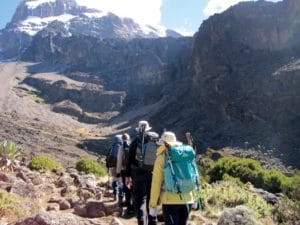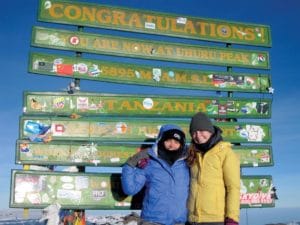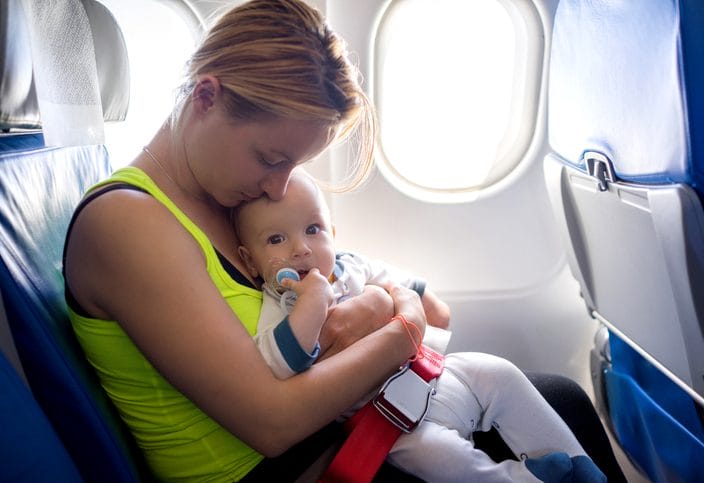In the early days of diagnosis, who would have thought it possible? But my celiac daughter and I were closing in on the top of Mount Kilimanjaro, the roof of Africa. From the Allergic Living archives, the full story of Kate and Melanie’s amazing adventure.
JUST AS the sunrise begins to melt the darkness at the top of Mount Kilimanjaro, my 17-year-old daughter Melanie crests the mountain’s first peak, Stella Point, a few steps ahead of me on the final leg of our 5 ½-day ascent to the summit.
We’ve climbed to just shy of 6,000 meters above sea level, and are nearing the end of the seven-hour “summit assault”. Trudging forward into a wicked wind chill, at sub-zero temperatures, our final 1,000 meter climb has been a brutal, grueling toil.
Tears that hours ago froze on my cheeks start flowing again as I cling to my daughter. I’m emotionally overwhelmed, physically spent, and yet struck with wonder and relief as the sun tinges the ancient African glacier pink.
Our team of 13 North American friends has labored through the frigid darkness since midnight, struggling against the increasing effects of altitude. Our crew has experienced nausea and vomiting, crashing headaches, dizziness and, for some, even hallucinations. Yet here we stand, all 13 of us, on top of the world’s highest free-standing mountain – “the roof of Africa”.
For me, the next hour, from Stella Point to Kili’s true summit, Uhuru Peak (5,895 meters above sea level) will be an exercise in pure willpower. With her pack on her back, water bottles frozen, and headlamp paling in the morning light, Melanie turns frequently to check on me as I struggle for every breath.
How far my brave girl and I have come – both literally and in our lives!
Early Years of Celiac Grief
As a toddler, Melanie endured months of illness until, at the age of 2, she was diagnosed with celiac disease. While it was good to know the cause and at last have a diet that would keep her well, I had mourned what I feared would be her loss of freedom. I worried about her life becoming focused on restriction.
That was in 1998, in the dark ages before the rise of gluten-free products. My first post-diagnosis trip to the grocery store left me with a nearly empty cart and a growing sense of panic – there’s something primal about a mother not being able to provide food for her child. I grieved her new lack of choices and my new duty to deny her all her favorite gluten-filled treats. How do you explain to a 2-year-old that she can no longer have her Sunday visit with “the croissant lady” at the bakery down the road?
As a medical journalist I researched, interviewed doctors and attended celiac disease conferences. When Melanie was 11, I began writing a book, along with a child psychologist, about finding liberation from the psychological limitations of the gluten-free diet.
The introduction began: “My daughter with celiac disease worries about ‘looking like a freak’. She packs two bags for a pajama party – one filled with her overnight stuff and one filled with food. She was the only kid who had to bring her own lunch to her school entrance exam, where a meal was provided for everyone else. Her class’s upcoming two-night trip weighs heavy on her mind. We’re not sure what, or how, she is going to eat. Sometimes she simply prefers to decline all food rather than draw attention to her condition.
“As her parents, we try to respect her choices. After all, she’s a nine-year veteran of living with celiac disease. But then again, she’s only 11 years old! A whole life of avoiding gluten stretches before her. One day I dream of seeing her follow in her parents’ footsteps, by slinging a pack on her back and embarking on a trek around the world.” The book never found a home – I was more focused on parenting than publishing – but a vision remained permanently etched in my heart: one day I wanted to see Melanie, backpack laden, heading off into a world of exploration and adventure.
Now, with the Tanzanian dawn hitting Uhuru Peak’s famous green and yellow sign up ahead, my vision is miraculously coming true.
Navigating the GF Food
After almost a week of ascending Mount Kilimanjaro, sleeping in tents on her slopes and eating meals prepared by our team of cooks, porters and guides, I was not alone in feeling a little fragile.
One by one our climbers had faltered. Nausea and diarrhea began as early as Day 2 for some of us. Our water was from mountain streams, boiled and treated with tablets, and that iffy sterilization, combined with the extreme altitude and unfamiliar food had taken a big toll. Yet Melanie was feeling better than most of us.
In the months leading up to the trip I had worried endlessly about gluten, fully aware that climbing Africa’s highest peak was not a place my daughter could afford to run out of food. The tour company’s website said they could accommodate food allergies, and when I emailed them, they seemed more than happy to oblige. To determine whether this could work out, I needed to ask a few pointed questions.
I learned that all food for the seven-day trek would be carried up the mountain by our porters, and the menu they sent me showed, not surprisingly, that gluten was a major player. So I jumped straight in with the fact that Melanie could not eat their bread, pasta or pancakes. “Could we bring our own substitutes and have the gluten-free pasta cooked in a separate pot?” I asked.
This was no small request. It meant a heavier load for the porters (we could not possibly carry any extra weight, given the altitude). It also meant more propane and water for cooking, and more dishes to clean. But their answer was “of course, this won’t be difficult for us, we are used to this”.
The trickier step was to dig down into the ingredients of all the soups, pasta sauces and stews on the menu. I could tell from our email exchanges that language might be a barrier here, so I decided to save these questions for our face-to-face meeting the day before the climb. To cover my bases, I would bring one main gluten-free meal per day (prepackaged curries that could be boiled in their plastic pouches) along with: safe pasta, instant oatmeal, and corn tortillas. We’d also take gluten-free energy bars and trail mix. And so, the adventure began.
The two cooks who accompanied our group spoke little English, so once we left I had to trust that the situation had been adequately explained to them.
Our initial dinner brought a first reassurance, when soup was served to the rest of us, along with a “special” bowl for Melanie. In an odd sense, breakfast was even more reassuring – the porridge, which I had been told would be fine, was immediately whisked away because it contained wheat. (I was so glad we had brought the instant packages, which we’d intended as snacks.) Each day, as we broke camp and plodded slowly and steadily upwards, our team of porters whizzed past us balancing baskets of fruit and cartons of eggs precariously on their heads. As we inched up rocky trails and along precipitous ridges, I had to stop myself from envisioning our precious gluten-free supplies toppling over the edge, never to be seen again.
On and up the mountain, the cooks produced “pancakes” from our tortillas, and gluten-free pasta arrived alongside everyone else’s. French fries were made exclusively for Melanie (much to the indignation of the other teenage team members, who only got prepackaged mashed potatoes).
I admit that I held my breath more than once. (I mistakenly thought I’d brought spaghetti and they served her fettuccini.) But the lesson I’ve been learning since Melanie’s childhood is to be vigilant but not afraid. And above all, not to let fear reign in my daughter’s quest for freedom.
As our altitude increased, our appetites receded (I lost six pounds on the trek), but thankfully Melanie’s only complaint was heartburn. Was that from gluten?
The thing about “gluten gut” (as one celiac friend calls it) is that I don’t know how it feels. Yes, Melanie has semi-regular stomach complaints, but then so does my niece who’s slightly older and does not have celiac. We know of only two definite gluten contaminations in the years since Melanie’s diagnosis – both of which resulted in a spectacular four hours of vomiting. But what about trace contamination? We’re careful at home, but we also love to eat out at accommodating restaurants. As far as I know she has never suffered from our adventures, but the last thing I wanted was to deal with a Kilimanjaro celiac crisis.
Before the trip, I had searched the internet and found a celiac blogger who had scaled the mountain. “Getting to the top of Mount Kilimanjaro on that last day was the hardest thing I’ve ever done,” Stephanie Diamond, a runner, wrote of her trek in 2009.
“The altitude can mess with your digestive system in ways similar to gluten contamination and by summit day I had no appetite at all,” she told me in an email. “I was completely fine once we started descending, though, so I’m sure it was the altitude, and not gluten, that got to me.”
Triumph at Kilimanjaro’s Peak
At the top of the Kilimanjaro, trailing behind Melanie, I point my trekking poles to the sky triumphantly and bask in the massive feeling of accomplishment that washes over me. For anyone, setting foot on Uhuru Peak is a feat to be proud of. But standing on top of the “roof of Africa,” with 15 years of celiac disease behind us, I felt a unique triumph of parenthood.
From Day 1 of the diagnosis, my husband and I had deliberated over the boundary lines of protection. Our first instinct in those early days was to rid our house of all foods that had made our daughter so sick. Suddenly, the world was a dangerous place. We would create a safe haven in our home – somewhere Melanie could eat without worry. We cleansed and purged.
But a few days later in playgroup, wandering over to the snack table when my back was turned, she had scooped up a handful of forbidden snacks and swallowed them with delight. This is the real world, I realized. She needed the tools to live here.
So began our quest to help her navigate through the real world while remaining fully integrated in it. Our philosophy has been to look for the solution and never let food, or lack of it, get in our way. Despite her dietary restrictions, Melanie has developed a love for travel and cuisine. As she’s grown up, she has taken increasingly more control, making her own inquiries about parties and school trips. She expanded her palate to include salad (finally!), and has developed a flair for gluten-free baking.
Above all, Melanie has learned the art of going with the flow. This is truly an art because it involves being prepared yet carefree, accepting what comes but having something to fall back on. She was hoping for pasta near the summit of Mount Kilimanjaro (which she got), but we packed half a ton of energy bars just in case.
Like so many parenting choices, the decision to tackle the slopes of Mount Kilimanjaro with a teen who has celiac disease required a careful assessment of risk versus benefit. A gluten “attack” was a real possibility that could never be completely ruled out, but we did everything possible to ensure against it. We were also most fortunate that our head guide, Julius Minja, and his team never once made me feel like my vigilance was annoying, and graciously accepted the extra work involved in keeping Melanie healthy.
Besides careful research, planning and packing for the trip, we had laid down a 17-year foundation of flexibility, open-mindedness, and adventurousness in our daughter. It led a girl and her once fearful mother to crowning success 5,895 meters above sea level – in the clouds of the African equator.
Note: This trip was not promotional; the author paid in full, and the tour company, Chagga Tours, was not aware of this article.










